D(+)-Trehalose dihydrate
Synonym(s):α,α-Trehalose;α-D -Glucopyranosyl-α-D -glucopyranoside;D -(+)-Trehalose dihydrate;1-O-α-D-Glucopyranosyl-α-D-glucopyranoside;1-O-alpha-D-Glucopyranosyl-alpha-D-glucopyranoside
- CAS NO.:6138-23-4
- Empirical Formula: C12H22O11·2H2O
- Molecular Weight: 378.33
- MDL number: MFCD00071594
- EINECS: 612-140-5
- SAFETY DATA SHEET (SDS)
- Update Date: 2024-11-19 23:02:33
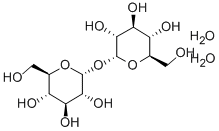
What is D(+)-Trehalose dihydrate?
Description
Trehalose is a natural non-reducing disaccharide composed of two α-glucose units. It is found in all major groups of organisms except vertebrates, has biological functions as an osmolyte, storage reserve, and stress protectant, and has diverse commercial applications. Trehalose can also induce or enhance autophagy.
Chemical properties
white to off-white crystalline powder
Chemical properties
D(+)-Trehalose dihydrate occurs as virtually odorless, white or almost white crystals with a sweet taste (approximately 45% of the sweetness of sucrose).
The Uses of D(+)-Trehalose dihydrate
D-(+)-Trehalose is a disaccharide composed of two α-glucose units. D-(+)-Trehalose is used in many processed foods as well as in biopharmaceutical monoclonal antibody formulations. D-(+)-Trehalose is also used as a protein stabilize.
The Uses of D(+)-Trehalose dihydrate
Food additive; pharmaceutical excipient
The Uses of D(+)-Trehalose dihydrate
An osmolyte, chemical chaperone, and inducer of autophagy.D-(+)-Trehalose is a disaccharide composed of two α-glucose units. D-(+)-Trehalose is used in many processed foods as well as in biopharmaceutical monoclonal antibody formulations. D-(+)-Trehalose is also used as a protein stabilizer.
The Uses of D(+)-Trehalose dihydrate
Stabilizes cells during freezing, freeze-drying and air-drying. Sweetener and stabilizer in foods; cryoprotectant for freeze-dried foods. Additive in cosmetics and personal care products.
What are the applications of Application
Trehalose dihydrate, cell culture is an osmolyte, chemical chaperone, and inducer of autophagy
What are the applications of Application
Trehalose, Dihydrate is an osmolyte, chemical chaperone, and inducer of autophagy
Production Methods
Trehalose is prepared from liquefied starch by a multistep enzymatic process. The commercial product is the dihydrate.
General Description
Trehalose is a naturally occurring disaccharide which is used as a nontoxic cryoprotectant of enzymes, membranes and vaccines. It serves as a carbohydrate reserve in microorganisms and protects them from adverse conditions.
Pharmaceutical Applications
D(+)-Trehalose dihydrate is used for the lyoprotection of therapeutic proteins, particularly for parenteral administration. Other pharmaceutically relevant applications include use as an excipient for diagnostic assay tablets; for stabilization during the freeze–thaw and lyophilization of liposomes; and for stabilization of blood cells, cosmetics, and monoclonal antibodies. Trehalose may also be used in formulations for topical application.
Biochem/physiol Actions
Trehalose is a non-reducing sugar formed from two glucose units joined by a 1-1 alpha bond. It is thought to provide plants and animals with the ability to withstanding periods of dehydration.
Safety
Trehalose is used in cosmetics, foods, and parenteral and
nonparenteral pharmaceutical formulations. It is generally regarded
as a relatively nontoxic and nonirritant material when used as an
excipient.
In the gut, trehalose is rapidly metabolized to glucose by the
specific enzyme trehalase. A small minority of the population
exhibits a primary (hereditary) or secondary (acquired) trehalase
deficiency and thus may experience intestinal discomfort after
ingestion of excessive amounts of trehalose owing to the osmotic
activity of undigested trehalose in the gut. However, smaller
amounts of trehalose are tolerated by such individuals without
any symptoms.
Trehalose is used as a sweetener and is reported to have
substantially less cariogenic potential than sucrose.
LD50 (dog, IV): >1 g/kg
LD50 (dog, oral): >5 g/kg
LD50 (mouse, IV): >1 g/kg
LD50 (mouse, oral): >5 g/kg
LD50 (rat, IV): >1 g/kg
LD50 (rat, oral): >5 g/kg
storage
Trehalose is a relatively stable material. At 60°C for 5 hours it loses
not more than 1.5% w/w of water (the dihydrate water of crystallization is retained). Open stored powder may liquefy at high
relative humidity (≥90%).
Trehalose should be stored in a cool, dry place in a well-sealed
container.
Purification Methods
α,α-D(+)-Trehalose crystallises (as the dihydrate) from aqueous EtOH. Dry it at 13o. For the anhydrous compound dissolve 10g in pyridine (200mL) and distil off this solvent at atmospheric pressure, and when the temperature rises to 115.3o all the H2O is removed and 73mL of distillate is collected. Most of the anhydrous material crystallises out at this stage. The crystals are collected (6.8g), washed with Et2O to give 6.1g of anhydrous product. Higher yields are obtained by slightly more prolonged distillation. [Birch J Chem Soc 3489 1965, X-ray cryst: Brown et al. Acta Cryst 28 3145 1972, Beilstein 17/8 V 3.]
Incompatibilities
Trehalose is incompatible with strong oxidizing agents, especially in the presence of heat.
Regulatory Status
GRAS listed. In the UK trehalose may be used in certain food applications. Included in parenteral and nonparenteral investigational formulations.
Properties of D(+)-Trehalose dihydrate
| Melting point: | 97-99 °C(lit.) |
| Boiling point: | 115.3 °C |
| alpha | 179 º (c=2, H2O) |
| refractive index | 181 ° (C=7, H2O) |
| FEMA | 4600 | TREHALOSE, DIHYDRATE |
| storage temp. | room temp |
| solubility | H2O: 50 mg/mL |
| form | powder |
| color | White to Off-White |
| optical activity | [α]20/D +179±3°, c = 2% in H2O |
| Water Solubility | 68.9 g/100 mL (20 ºC) |
| Sensitive | Hygroscopic |
| Merck | 14,9580 |
| BRN | 5322018 |
| CAS DataBase Reference | 6138-23-4(CAS DataBase Reference) |
Safety information for D(+)-Trehalose dihydrate
| Signal word | Warning |
| Pictogram(s) |
 Exclamation Mark Irritant GHS07 |
| GHS Hazard Statements |
H315:Skin corrosion/irritation H319:Serious eye damage/eye irritation H335:Specific target organ toxicity, single exposure;Respiratory tract irritation |
| Precautionary Statement Codes |
P261:Avoid breathing dust/fume/gas/mist/vapours/spray. P305+P351+P338:IF IN EYES: Rinse cautiously with water for several minutes. Remove contact lenses, if present and easy to do. Continuerinsing. |
Computed Descriptors for D(+)-Trehalose dihydrate
| InChIKey | DPVHGFAJLZWDOC-NYAOJISMSA-N |
D(+)-Trehalose dihydrate manufacturer
SOLFYN INTERNATIONAL LLP
Anand Agencies
New Products
(S)-3-Aminobutanenitrile hydrochloride 4-Methylphenylacetic acid N-Boc-D-alaninol N-BOC-D/L-ALANINOL Tert-butyl bis(2-chloroethyl)carbamate 3-Morpholino-1-(4-nitrophenyl)-5,6-dihydropyridin- 2(1H)-one Furan-2,5-Dicarboxylic Acid Tropic acid 1-Bromo-3,5-Di-Tert-Butylbenzene S-2-CHLORO PROPIONIC ACID ETHYL ISOCYANOACETATE 2-Bromo-1,3-Bis(Dimethylamino)Trimethinium Hexafluorophosphate 4-IODO BENZOIC ACID 3-NITRO-2-METHYL ANILINE 1-(2,4-DICHLOROPHENYL) ETHANAMINE (2-Hydroxyphenyl)acetonitrile 4-Bromopyrazole 2-(Cyanocyclohexyl)acetic acid 4-methoxy-3,5-dinitropyridine 1-(4-(aminomethyl)benzyl)urea hydrochloride 2-aminopropyl benzoate hydrochloride diethyl 2-(2-((tertbutoxycarbonyl)amino) ethyl)malonate tert-butyl 4- (ureidomethyl)benzylcarbamate Ethyl-2-chloro((4-methoxyphenyl)hydrazono)acetateRelated products of tetrahydrofuran
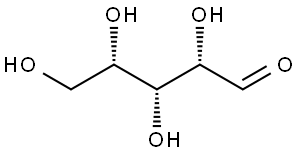
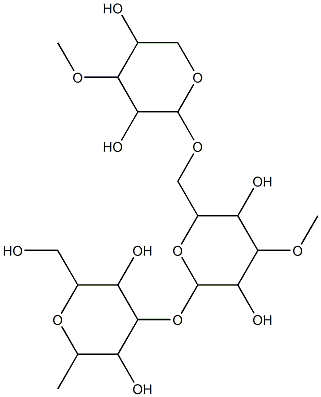
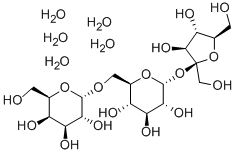


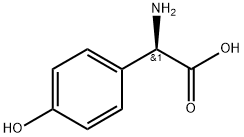
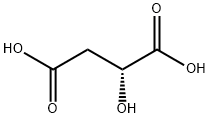

You may like
-
 6138-23-4 D-(+)-TREHALOSE 2-HYDRATE 99%View Details
6138-23-4 D-(+)-TREHALOSE 2-HYDRATE 99%View Details
6138-23-4 -
 D-Trehalose CAS 6138-23-4View Details
D-Trehalose CAS 6138-23-4View Details
6138-23-4 -
 D-Trehalose Dihydrate extrapure CHR CAS 6138-23-4View Details
D-Trehalose Dihydrate extrapure CHR CAS 6138-23-4View Details
6138-23-4 -
 D-( )-Trehalose dihydrate 98.00% CAS 6138-23-4View Details
D-( )-Trehalose dihydrate 98.00% CAS 6138-23-4View Details
6138-23-4 -
 D-(+)-Trehalose Dihydrate CAS 6138-23-4View Details
D-(+)-Trehalose Dihydrate CAS 6138-23-4View Details
6138-23-4 -
 TREHALOSE For Biochemistry CAS 6138-23-4View Details
TREHALOSE For Biochemistry CAS 6138-23-4View Details
6138-23-4 -
 Trehalose, Dihydrate CAS 6138-23-4View Details
Trehalose, Dihydrate CAS 6138-23-4View Details
6138-23-4 -
 Trehalose CAS 6138-23-4View Details
Trehalose CAS 6138-23-4View Details
6138-23-4